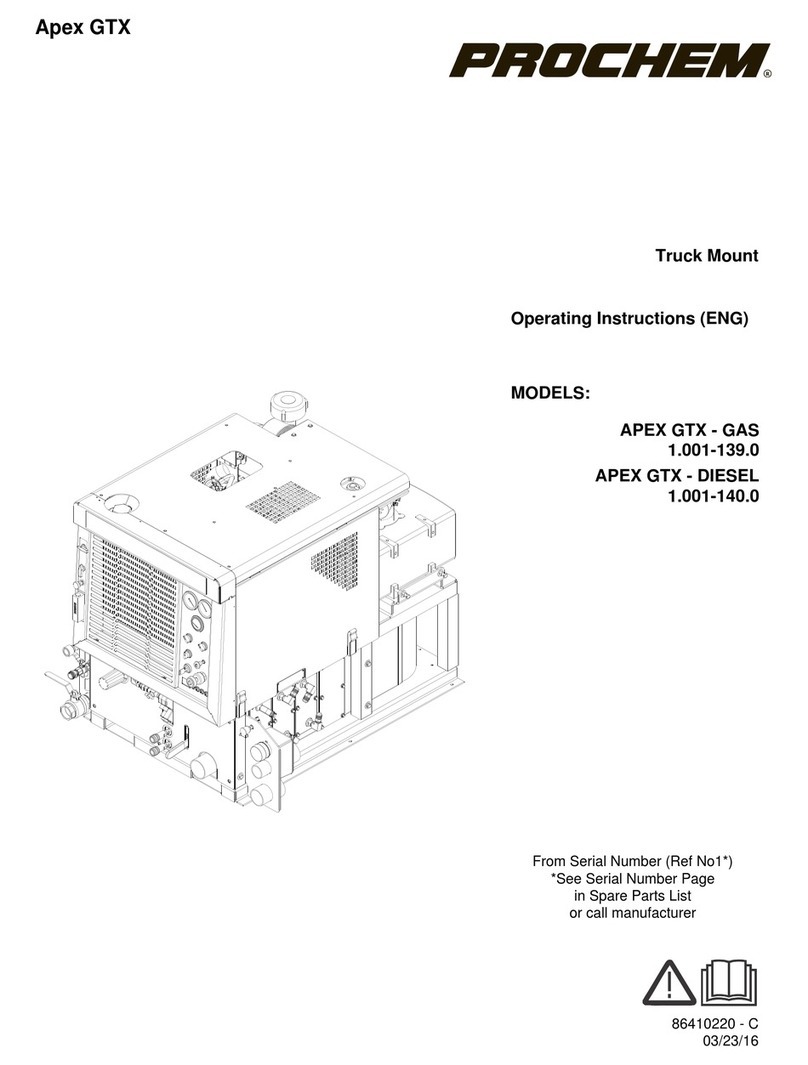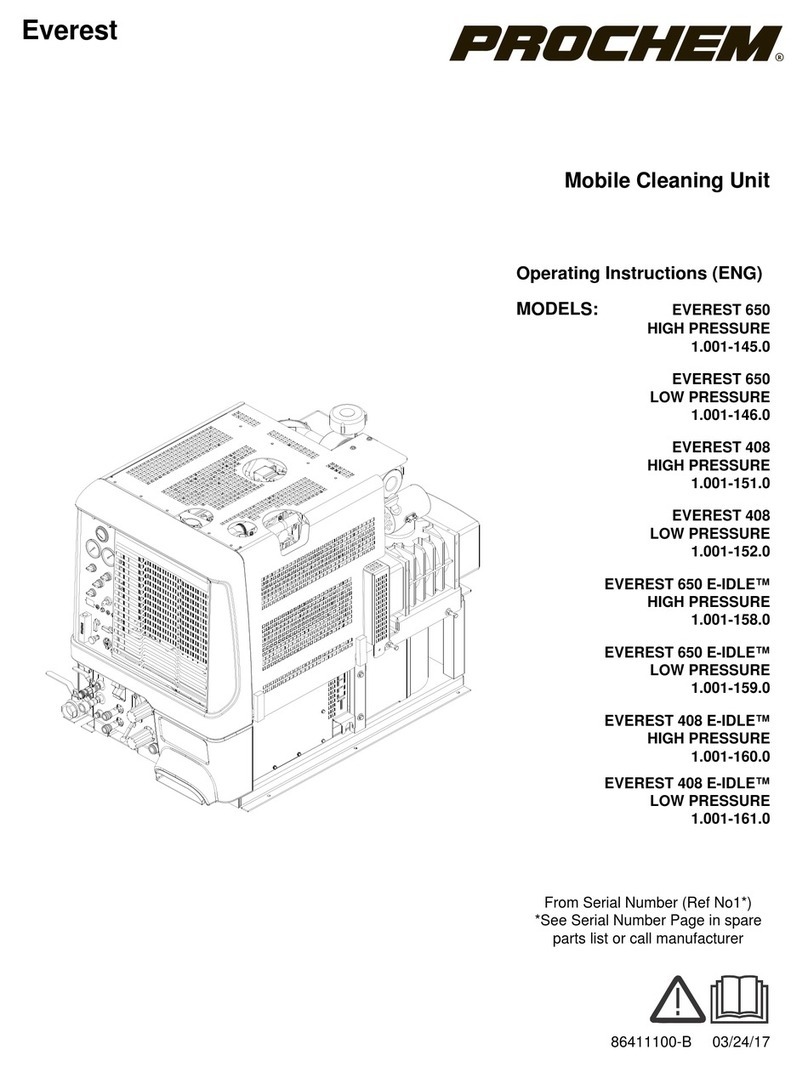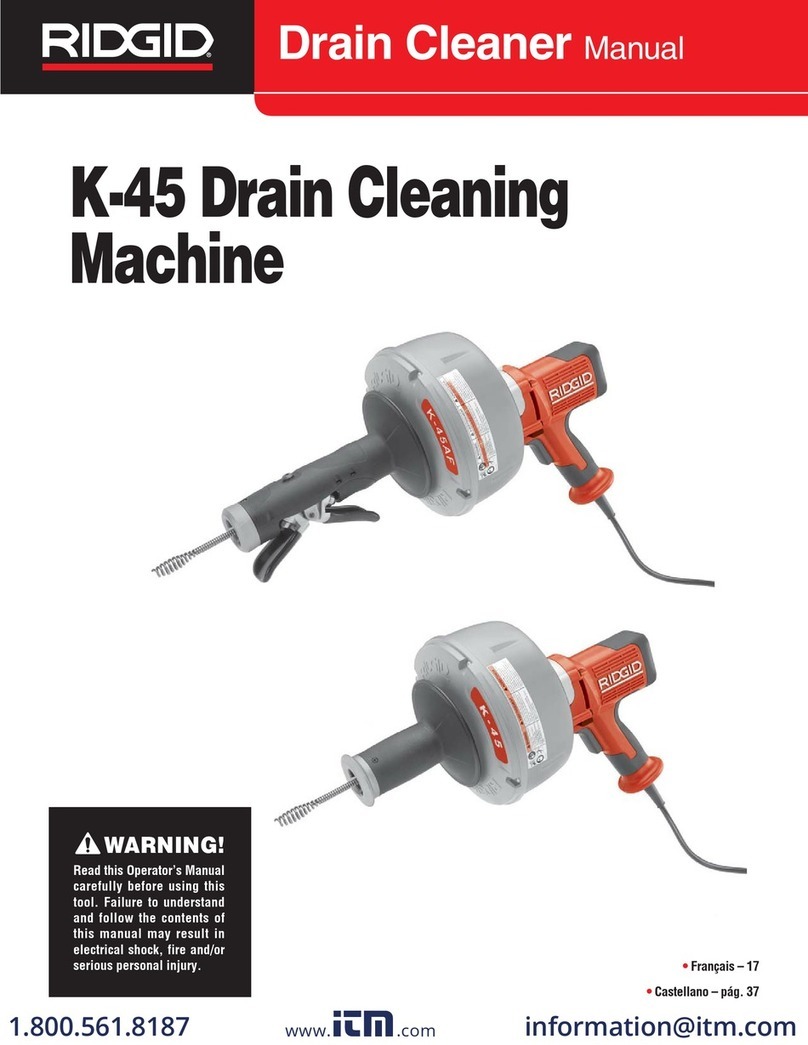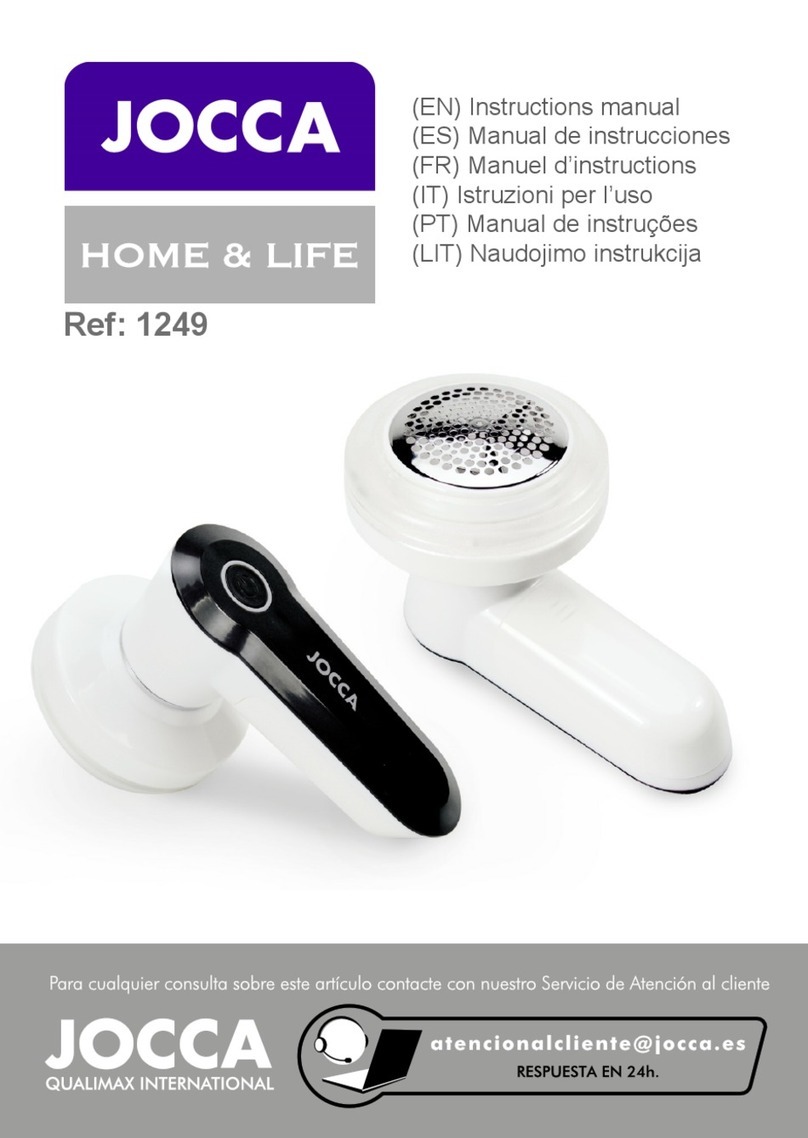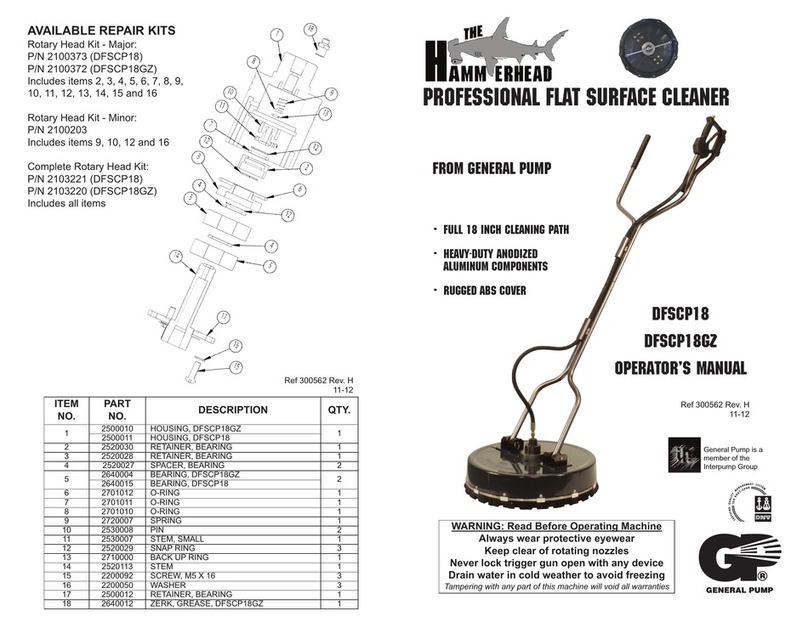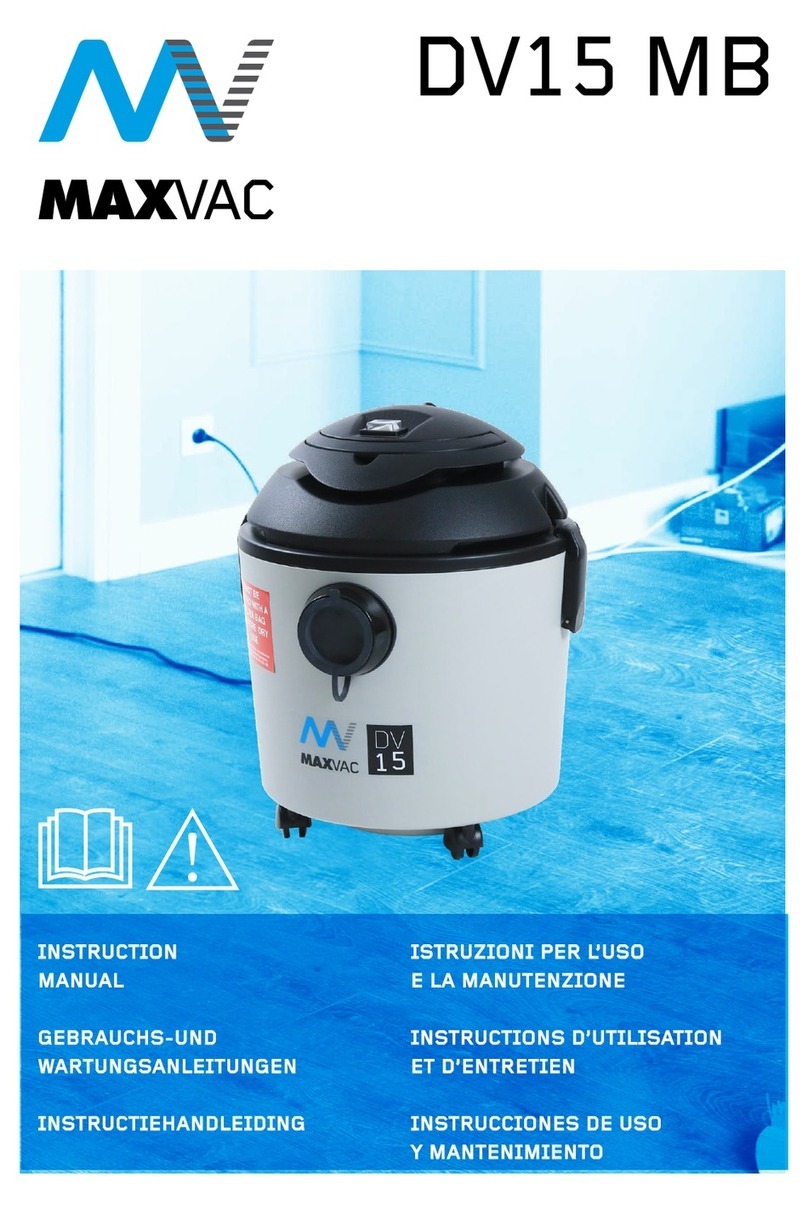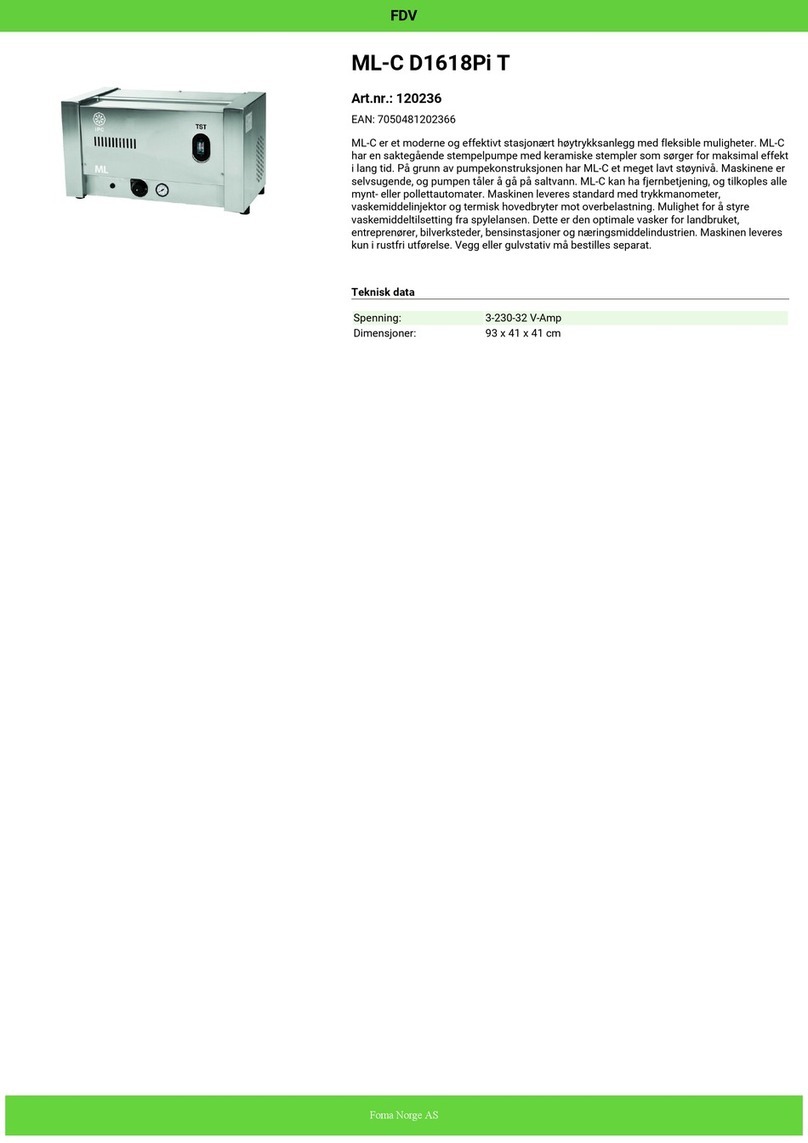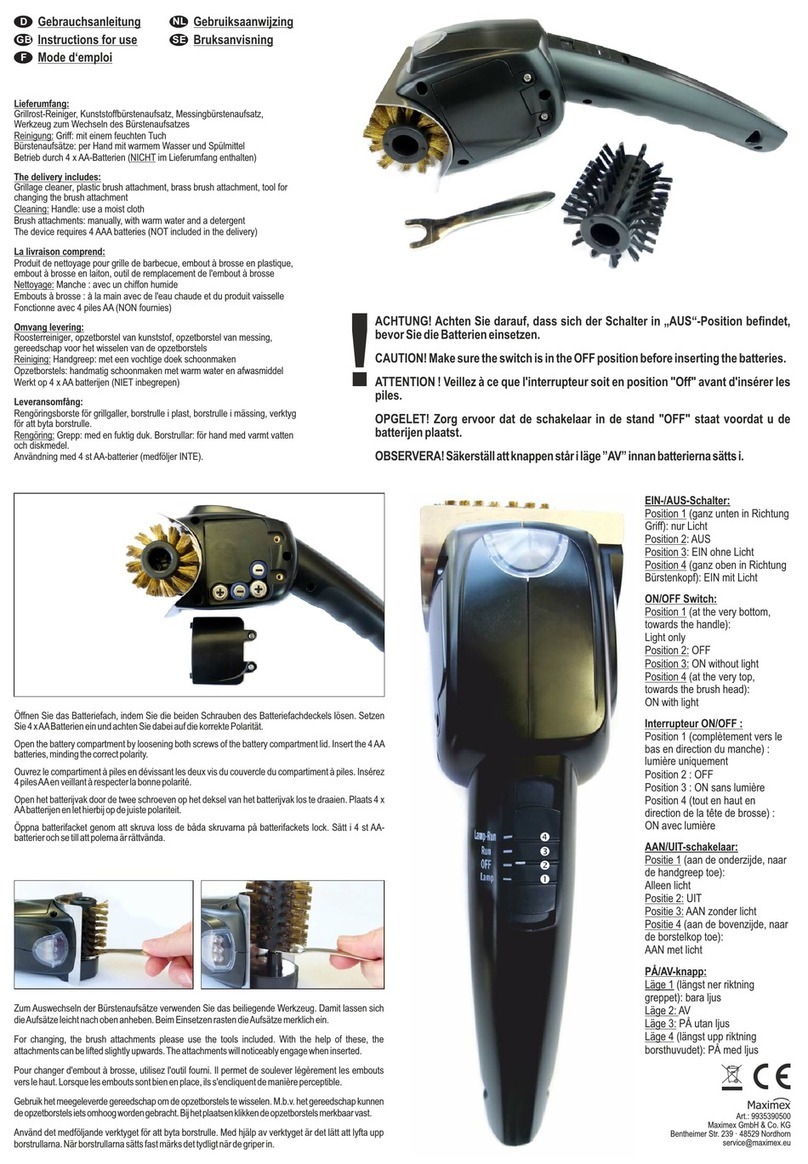Prochem PEAK User manual

BN 86037220 03/12/09
PRV NO. 980116
Operating Instructions (ENG)
MODELS: PEAK
Read instructions before operating the machine.


MACHINE DATA LOG/OVERVIEW
PEAK 86037220 02/12/07 1
Welcome…and congratulations on the purchase of your Mobile Cleaning Unit. This instruction manual is a guide
for operating and servicing your unit. Read this manual completely before installing or operating this unit.
This unit offers you personal convenience. All of your instrumentation and controls have been positioned to give
you easy access for operation and daily maintenance.
Proper operation and service are essential to the efficient functioning of this unit. When maintained correctly, this
unit will have a long, trouble-free life.
The service methods described in this manual are explained in such a manner that servicing may be performed
accurately and safely. Proper service varies with the choice of procedure, the skill of the mechanic, and the tools
or parts available. Before attempting any repair, make certain that you are thoroughly familiar with this equipment
and are equipped with the proper tools. Any questions pertaining to operating or servicing this unit should be
directed to your nearest dealer.
THIS UNIT MUST BE INSTALLED BY THE DEALER FROM WHOM YOU PURCHASED IT IN ACCORDANCE
WITH THE PRESCRIBED INSTALLATION PROCEDURES.
MAKE CERTAIN THAT THE WARRANTY CARD IS FILLED OUT AT THE TIME OF INSTALLATION AND IS
RETURNED TO YOUR DEALER.
PROFESSIONAL CHEMICALS CORPORATION
325 SOUTH PRICE ROAD
CHANDLER, ARIZONA 85224
Information in this document is subject to change without notice and does not represent a commitment on the part
of Professional Chemicals Corporation.
YOUR DEALER
NAME: _________________________________________________________________________________________________
ADDRESS: _______________________________________________________________________________________________
PHONE NUMBER: _________________________________________________________________________________________
MODEL _______________________________________
DATE OF PURCHASE __________________________
SERIAL NUMBER ______________________________
SALES REPRESENTATIVE # _____________________

TABLE OF CONTENTS
PEAK 86037220 02/12/07
2
Machine Data Log/Overview.........................1
Table of Contents .........................................2
Receiving Your Unit......................................4
HOW TO USE THIS MANUAL
How to use this Manual. ...............................1-1
SAFETY
Safety Instructions........................................2-1
Hazard Intensity Level..................................2-3
OPERATION & SYSTEMS
Technical Specifications...............................3-1
Installation Requirements.............................3-2
Fuel Requirements .......................................3-2
Engine Oil Requirements..............................3-2
Components ............................................... 3-4
Water Pumping And Heat
Transfer System ......................................... 3-7
Chemical Injection System ......................... 3-9
Vacuum System.......................................... 3-10
Pre-run Inspections..................................... 3-11
Priming the Chemical Pump....................... 3-12
Waste Pump............................................... 3-12
Cleaning...................................................... 3-12
Upholstery Cleaning ................................... 3-13
Shutdown and Daily Maintenance.............. 3-13
De-flooding Operations............................... 3-13
Freezing Protection..................................... 3-13
Winterizing Your Unit.................................. 3-14
Removing Anti-freeze from Unit.................. 3-15
MAINTENANCE & SERVICE
Maintenance
Maintenance Schedule ...........................4-1
Key Maintenance Checkpoints ...............4-3
Engine.....................................................4-4
Vacuum Pump ........................................4-5
Water Pump............................................4-6
Vacuum Inlet Filter..................................4-6
Vacuum Relief Valve...............................4-6
Vacuum Drive Belts, Pulleys And Hubs..4-6
Water Pump Drive Belt ...........................4-7
Float Valve (Water Box)..........................4-7
Waste Tank Strainer Basket ...................4-7
Y-Strainer (Outlet)...................................4-7
Check Valve (Outlet)...............................4-7
Chemical Pump.......................................4-7
Chemical And Heat
Bypass Valves ........................................4-7
Nitrogen Accumulator .............................4-8
Pressure Regulator.................................4-8
Vacuum Hoses........................................4-8
High Pressure Hoses..............................4-8
Optional Waste Pump-out.......................4-8
Engine Coolant Replacement.................4-8
General Service Adjustments
Engine Speed .........................................4-9
Check Valve (Solution Outlet).................4-9
Water Box...............................................4-9
Chemical Pump.......................................4-9
Chemical And Heat Bypass Valves.........4-9
Packing Nut Adjustment
(Chemical Metering & Selector Valves) ..4-10
Pressure Regulator.................................4-10
Troubleshooting......................................4-11

TABLE OF CONTENTS
PEAK 86037220 02/12/07 3
PARTS LIST
Framework..................................................5-1
Side Panel...................................................5-7
Chemical Control Panel..............................5-9
Control Panel..............................................5-11
Engine.........................................................5-13
Vacuum Blower...........................................5-15
Water Pump................................................5-17
Vacuum/Exhaust Heat Exchanger
And Silencer................................................5-21
Heli-Coil Heat Exchanger............................5-23
Solution Manifold ........................................5-25
Water Box ..................................................5-27
Pressure Regulator Manifold ......................5-29
Waste Tank.................................................5-31
Hose Accessories.......................................5-33
Battery-Floor Mount....................................5-35
Automatic Pumpout (Optional)....................5-37
Wand- Titanium Six Jet (Optional)..............5-41
Wand - Quad-Jet (Optional)........................5-43
Wand – Tri-Jet (Optional)............................5-45
Stair Tool (Optional)....................................5-47
Upholstery Tool (Optional)..........................5-49
Shelf Assembly (Optional) ..........................5-51
Water Tank, Dual With
Demand Pump (Optional)...........................5-53
Water Tank-Demand Pump (Optional) .......5-55
Auxiliary Water Tank With Pump................5-57
Hose Reel (Optional) ..................................5-59
Wiring Diagram...........................................5-61
Hose Diagram.............................................5-62
Warranty .....................................................5-64

RECEIVING YOUR UNIT
PEAK 86037220 02/12/07
4
ACCEPTANCE OF SHIPMENT
Every part of your cleaning unit was carefully
checked, tested, and inspected before it left our
manufacturing plant. Upon receiving the unit, make
the following acceptance check:
1. The unit should not show any outward signs of
damage. If damaged, notify the delivering carrier
immediately.
2. Check your equipment and packing list. The
cleaning unit should arrive equipped with the
following items (unless otherwise specified).
NOTE: Your distributor from whom you
purchased this mobile cleaning unit is
responsible for the correct installation of this
machine. The dealer is also responsible for initial
training of your operators and maintenance
personnel in the proper operation and
maintenance of this unit.
EQUIPMENT LIST:
1. Console.
2. Waste tank
3. Hose clamps for vacuum hoses.
4. 100 ft. of 2” vacuum hose.
5. 1 vacuum hose connection.
6. 100 ft. of 1/4" high pressure hose with quick
connects.
7. 50 ft. water supply hose with quick connect.
8. Installation bolting kit.
9. Installation mounting plates.
10. Operation and service manual for engine, water
pump, and vacuum pump.

HOW TO USE THIS MANUAL
PEAK 86037220 02/12/07 1-1
This manual contains the following sections:
- HOW TO USE THIS MANUAL
- SAFETY
- INSTALLATION REQUIREMENTS
- SYSTEMS
- OPERATIONS
- MAINTENANCE & SERVICE
- PARTS LIST
The HOW TO USE THIS MANUAL section will tell
you how to find important information for ordering
correct repair parts.
Parts may be ordered from authorized dealers.
When placing an order for parts, the machine model
and machine serial number are important. Refer to
the MACHINE DATA box which is filled out during
the installation of your machine. The MACHINE
DATA box is located on the inside of the front cover
of this manual.
The model and serial number of your machine is on
the side approximately where shown.
The SAFETY section contains important information
regarding hazard or unsafe practices of the
machine. Levels of hazards is identified that could
result in product or personal injury, or severe injury
resulting in death.
The OPERATIONS section is to familiarize the
operator with the operation and function of the
machine.
The MAINTENANCE section contains preventive
maintenance to keep the machine and its
components in good working condition. They are
listed in this general order:
- Engine
- Vacuum Pump
- Water Pump
- Drive Belts, Pulleys & Hubs
- Chemical Pump
- Hoses
- Vac/Exhaust Heat Exchanger
- General Service Adjustments
- Troubleshooting
The PARTS LIST section contains assembled parts
illustrations and corresponding parts list. The parts
lists include a number of columns of information:
- REF – column refers to the reference
number on the parts illustration.
- PART NO. – column lists the part
number for the part.
- PRV NO. – reference number.
- DESCRIPTION – column is a brief
description of the part.
- SERIAL NO. FROM – column indicates
the first machine the part number is
applicable to. When the machine design
has changed, this column will indicate
serial number of applicable machine.
The main illustration shows the most
current design of the machine. The
boxed illustrations show older designs. If
column has an asterisk (*), call
manufacturer for serial number.
-NOTES – column for information not
noted by the other columns.
NOTE: If a service or option kit is installed on
your machine, be sure to keep the KIT
INSTRUCTIONS which came with the kit. It
contains replacement parts numbers needed for
ordering future parts.
NOTE: The number on the lower left corner of
the front cover is the part number for this
manual.
MODEL _____________________________________
DATE OF PURCHASE ________________________
SERIAL NUMBER ____________________________
SALES REPRESENTATIVE # ___________________

PEAK 86037220 02/12/07
2-1
IMPORTANT SAFETY INSTRUCTIONS
When using this machine, basic precautions
must always be followed, including the following:
READ ALL INSTRUCTIONS BEFORE USING THIS MACHINE.
Read the operator's manual before installing or starting this unit. Failure to adhere to instructions could
result in severe personal injury or could be fatal.
Operate this unit and equipment only in a well-ventilated area. Exhaust fumes contain carbon monoxide
which is an odorless and deadly poison that can cause severe injury or fatality. DO NOT run this unit in an
enclosed area. DO NOT operate this unit where the exhaust may enter any building doorway, window, vent, or
opening of any type.
Gasoline is extremely flammable and its vapors can explode if ignited. Store gasoline only in approved
containers, in well-ventilated, unoccupied buildings away from sparks or flames. Never carry any gasoline or
flammable material in the vehicle. Fumes may accumulate inside the vehicle and ignite, causing an explosion.
DO NOT store any type of flammable material in the vehicle.
This unit must be operated with the vehicle or trailer doors open in order to ensure adequate engine
ventilation.
DO NOT operate engine if gasoline is spilled. Avoid creating any ignition until the gasoline has been cleaned
up. Never use gasoline as a cleaning agent.
DO NOT place hands, feet, hair, or clothing near rotating or moving parts. Avoid any contact with moving
parts! Rotating machinery can cause injury or fatality.
Never operate this unit without belt guards or hoods. The high speed moving parts, such as belts and pulleys,
should be avoided while this unit is running. Severe injury, damage, or fatality may result.
DO NOT service this unit while it is running. The high-speed mechanical parts as well as high temperature
components may result in severe injury or severed limbs.
Never touch electrical wires or components while the engine is running. They can be sources of electrical
shock.
Engine components can get extremely hot from operation. To prevent severe burns, DO NOT touch these
areas while the engine is running - or immediately after the engine is turned off.
DO NOT touch the exhaust system while this unit is running. Severe burns may result.
Before servicing this unit, allow it to "cool down." This will prevent burns from occurring.
Water under high pressure at high temperature can cause burns, severe personal injury, or fatality. Shut
down machine, allow to cool down, and relieve system of all pressure before removing valves, caps,
plugs, fittings, filters, and bolts.
Always wear hearing protection when unit is running. Always comply with local noise ordinance when
operating units.
These symbols mean WARNING or CAUTION. Failure to follow warnings and
cautions could result in fatality, personal injury to yourself and/or others, or
property damage. Follow these instructions carefully!

PEAK 86037220 05/22/08 2-2
DO NOT leave the vehicle engine running while operating this unit.
Dangerous Acid, Explosive Gases! Batteries contain sulfuric acid. To prevent acid burns, avoid contact with
skin, eyes and clothing. Batteries produce explosive hydrogen gas while being charged. To prevent a fire or
explosion, charge batteries only in well ventilated areas. Keep sparks, open flames, and other sources of ignition
away from the battery at all times. Keep batteries out of the reach of children. Remove all jewelry when servicing
batteries.
Before disconnecting the negative (-) ground cable, make sure all switches are OFF. If ON, a spark will occur at
the ground cable terminal which could cause an explosion if hydrogen gas or gasoline vapors are present. When
disconnecting the battery, ALWAYS disconnect the negative (-) terminal FIRST.
DO NOT smoke around the unit. Gas fumes may accumulate and be ignited. The battery is also extremely
flammable. This will prevent possible explosions.
DO NOT damage the vehicle in any manner during installation. When routing fuel lines DO NOT place the
hose in any location where damage may occur to the hose or vehicle. Avoid any contact with moving parts, areas
of high temperature, brake lines, fuel lines, muffler, catalytic converter, or sharp objects.
Use only ProChem supplied fuel installation kits. Ensure to use the kit specific for the truckmount model and
van model being used. When traversing the vehicle floor with fuel lines, always use a bulkhead adapter. This will
prevent leakage and ensure that the hose is not punctured by vehicle vibration abrasion.
DO NOT exceed your vehicle's weight limit. The console with waste tank and accessories weighs
approximately 990 lbs. Make certain to account for any additional accessories in your weight and balance
calculations. Make certain that the vehicle has the correct axle rating. This will prevent unsafe vehicle driving
conditions.
We require high-back seats on all vehicles in which units are to be installed for head and neck protection.
We recommend using a metal partition between the seats and equipment.
DO NOT operate this unit without the water supply attached and turned on. The water pump and other vital
components may be seriously damaged if this unit is permitted to operate dry without water.
DO NOT operate this unit without the filter installed in the waste tank.
Keep your vehicle work area clean. Wands, stair tools, and other accessories must be securely fastened before
driving the vehicle.
All high pressure hoses must be rated for 3000 PSI at 250°F. Thermoplastic hoses do not meet these
specifications and should not be used. Severe burns and injury may result if the hoses do not meet these
requirements.
The winterizing loop hose assembly, Part #86260700, PRV NO. 10-805380, is for winterizing use only. If
used improperly, live steam may escape from this hose, causing it to whip around. Burns or injury may result.
Make certain that you receive complete training by the distributor from whom you purchased this unit.
This unit uses high pressure and temperature. Improper or irresponsible use may result in serious injury.
Do not modify this unit in any manner. Improper modification can cause severe personal injury or fatality.
CALIFORNIA PROPOSITION 65 WARNING: Engine exhaust from this product contains chemicals known to the
State of California to cause cancer, birth defects, or other reproductive harm. Running with out adequate water
supply could damage water pump. Ensure always to have an adequate water supply.

HAZARD INTENSITY LEVEL
PEAK 86037220 02/12/07
2-3
The following WARNING LABELS are found on your cleaning unit. These labels point out
important Warnings and Cautions which should be followed at all times. Failure to follow
warnings and cautions could result in fatality, personal injury to yourself and/or others, or
property damage. Follow these instructions carefully! DO NOT remove these labels.
NOTE: If at any time the labels become illegible, promptly replace them.
Front panel decal
With warning labels
86179290
PRV NO. 500875
Caution label
86186530
PRV NO. 500770
(2 Warning labels required
(1) Top of belt guard
(1) Top of rear engine panel
Warning label
86186520
PRV NO. 500769
SOLUTION OUTLET
LUBRICATE REGULATOR SEALS
EVERY 50 HOURS.
RECOMMENDED LUBRICANT:
SYNCO SUPER LUBE
SOLUTION PRESSURE
REGULATOR
CONDENSED OPERATING INSTRUCTIONS
1. CONNECTWATERHOSE TO WATERINLET CONNECTIONANDTURN ON WATERSUPPLY.
2. CONNECTCLEANINGAND VACUUMHOSES TO THEDESIRED CLEANINGTOOL ANDCONSOLE.
3. PULL OU T ENGINE CH OKE,TURN SOL UTION PUM P TO OVERRID E AND TURN IGNITION KEY TO S TART.
4. PUSHIN ENGINE CHOKE AFTERENGINE HAS STARTED.
5. SET THROTTL EA TI DLE (PUSH THROTTLE CAB LE IN)
6. INSERT CHEMICAL INLET AND PRIME TUBING INTO C HEMICAL CONTAINER.
7. TURN CH EMICAL PRIM E VALVE TO P RIME AND ALL OW CHEMICAL TO CIRC ULATE. AFTE R ALL AIR B UBBLES HAVE BEEN REM OVED FROM T HE CHEMICAL
TUBING, TURN TH E CHEMICAL PRIME VALV ET O THE ON POSITION AND OPEN T HE CHEMICAL FLOW VA LVE. WITH THE TOOL ATTAC HED AND THE CHEMICAL
FLOW VALVE OPEN, SET THE DESIRED CHEMICAL FL OWR ATEW HILE OBSERVING THE FLOW METER INDICATOR.
8. FOR QUIC K HEAT-UP, REFER TO OPERAT ING INSTRUCT IONS.
1.CLOSE CHEMICALMETERING VALVE.
2. ALLOW THE UNIT TO RU N FOR 2 MINUTES WITH THE VACU UM HOSE DISCONNEC TED TO REMOVE MOISTUR E AND SPRAY WD40 (OR EQUI VALENT) INTO
THE VACUUM LUBRICATIO N CUP. THIS WILL P REVENT CORROSION DUE TO MOISTURE.
3. SETENGINE THROTTLEAT IDLE POSITIONAND OPEN TEMP CONTROLVALVE, ALLOWINGTHE WATER TEMPERATURETO COOL DOWN.
4. TURNOFF IGNITIONSWITCH.
5.DISCONNECTALL HOSES AND TOOLS.
6. DRAINWASTE TANKINTO AN APPROVEDSOURCEAND RINSE WITHCLEAN WATER.
SOLUTION SCREEN
CHEMICAL
CHECK VALVE
SHUTDOWN AND DAILY MAINTENANCE
STARTING

OPERATION
PEAK 86037220 02/12/07 3-1
TECHNICAL SPECIFICATIONS
ITEM DIMENSION/CAPACITY
Engine speed 2850 rpm (high speed) Water Pump ON
1200 rpm (idle speed) Water Pump OFF.
Water pump rpm 1750 rpm
Vacuum pump rpm 3250 rpm
Water flow rate 3.5 GPM (maximum)
Water pump pressure (low pressure) 1000 PSI (maximum)
Vacuum relief valve 13” Hg
Waste tank capacity 60 gallons
Console weight 770 lbs.
Console weight (with waste tank & waste tank
accessories)
990 lbs.
TORQUE VALUES
Engine hub 300 inch lbs 25 foot/lbs
Vacuum pump hub 300 inch/lbs 25 foot/lbs
Front engine pulley 216 inch/lbs 18 foot/lbs
Water pump clutch shaft bolt 300 inch/lbs 25 foot/lbs
JET SIZING:
Recommended floor tool tip sizing not exceed a total of “.045”. Using larger jet sizes on your cleaning unit may
reduce cleaning temperatures.
Example: Tri-jet wand uses three 95015 jets (95° spray angle w/ 015 orifice).
015 X 3 = 045
Upholstery tool jet size: 80015
Stair tool jet size: 9502

OPERATION
PEAK 86037220 02/12/07
3-2
INSTALLATION REQUIREMENTS
NOTE: Your distributor from whom you
purchased this mobile cleaning unit is
responsible for the correct installation of this
machine. The dealer is also responsible for initial
training of your operators and maintenance
personnel in the proper operation and
maintenance of this unit.
1. The unit should NOT be mounted in any motor
vehicle of less than 3/4 ton capacity.
The console with waste tank and accessories must
NOT exceed the vehicle's axle weight limit.
2. If mounting in a trailer, make certain that the
trailer is rated for the total weight of the UNIT
AND TRAILER. Electric or hydraulic brakes
should be provided, and a strict compliance with
any State and Federal vehicle laws must be
maintained.
3. The vehicle tires should have a load rating above
the combined vehicle and unit weight.
4. We do not recommend using flooring materials
that absorb water. This could result in rust and
corrosion of the vehicle floor.
5. Padding under rubber floor mats should be
removed before installing this unit.
6. We highly recommend using a aluminum drip tray
under the console (Part #86055040, PRV NO.
790552).
7. If using a trailer, the console should be positioned
so that it balances properly with respect to the
axle. Ten percent (10%) of the overall unit weight
should be on the tongue.
Example: If loaded trailer weight is 2,000 lbs.,
tongue weight needs to be a minimum of
200 lbs. to tow properly.
FUEL REQUIREMENTS2. FUEL
REQUIREMENTS
Use unleaded gasoline ONLY. DO NOT use any
gasoline additives. We recommend the use of clean,
fresh, unleaded gasoline intended for automotive
use. High octane gasoline should NOT be used with
the engine on this unit.
ENGINE OIL REQUIREMENTS3OIL
REQUIREMENTS
Using the proper type and weight of oil in the
crankcase is extremely important. So is checking oil
daily and changing oil regularly. Failure to use the
correct oil, or using dirty oil, causes premature engine
wear and failure.
OIL TYPE
Use high quality detergent oil of API (American
Petroleum Institute) service class SG, SH, SJ or
higher. Synthetic oils may be used. Select the
viscosity based on the air temperature at the time of
operation as shown in the following table.
NOTE: Using other than service class SG, SH, SJ or
higher oil or extending oil change intervals longer
than recommended can cause engine damage.
A logo or symbol on oil containers identifies service
class and SAE viscosity grade. See figure below.
Oil Change Logo
SPECIAL ALTITUDE REQUIREMENTS
Operation at higher altitudes may require a special
carburetor fuel nozzle. If you operate unit your above
5000 feet, you should order the Kohler high altitude
kit Part #48102.
RECOMMENDED SAE VISCOSITY GRADES
F-20 0 20 32 40 60 80 100
C-30 -20 -10 010 20 30 40
***
isacceptableupto4°C(40±F).
**Syntheticoilswillprovidebetterstartinginextreme
coldbelow-23°C(-10°F).
*Useofsyntheticoilhaving5W-20or5W-30rating
10W-30
Kohler “Command”
5W-20, 5W-30

OPERATION
PEAK 86037220 02/12/07 3-3
HARD WATER MAP
CHEMICAL REQUIREMENTS4.
C
This cleaning unit, due to its chemical injection pump
design, can be used with a variety of water-diluted
chemical compounds (either acidic or alkaline),
depending on the job to be done. However, to obtain
optimum results with this unit, we recommend using
the PROCHEM line of chemicals. For information on
using the cleaning compounds, refer to the
PROCHEM chemical manual.
WATER REQUIREMENTS
Hard water deposits will adversely affect the
plumbing and heat exchange systems on this unit.
The map below will give you an idea of where areas
of high water hardness may occur. However, any
water supply obtained from a well is almost always
hard water and a water softener will be needed to
protect your equipment.
NOTE: Equipment malfunction or component
failure caused by hard water scaling is NOT
covered under the warranty.
If you are operating this unit in an area where the
unit will be using water in which the hardness
exceeds
3-1/2 grains, we highly recommend a suitable water
softener be installed. If using a water softener, it
must have a five (5) GPM (or greater) flow capacity
without any hose constrictions.
Using a water softener will reduce maintenance and
decrease down time caused by hard water scaling. It
will also allow cleaning chemicals to be more
effective in lower concentrations.
If you require a water softener, PROCHEM has a
model to meet your needs. Please contact your
nearest distributor for information, price, and
availability.

OPERATION
PEAK 86037220 02/12/07
3-4
STARTING
SHUTDOWN AND DAILY MAINTENANCE
CHEMICAL
CHECK VALVE
SOLUTION SCREEN
1. CLOSE CHEMICAL METERINGVALVE.
2. ALLOW THE UNIT TO RUN FOR 2MINUTES WITH THE VACUUM HOSE DISCONNECTED TO REMOVEMOISTURE AND SPRAY WD40 (OR EQUIVALENT) INTO
THE VACUUM LUBRICATIONCUP. THIS WILL PREVENT CORROSIOND UET OMOISTURE.
3. SET ENGINE THROTTLE AT IDLE POSITION AND OPEN TEMP CONTROL VALVE, ALLOWING THE WATER TEMPERATURE TO COOL DOWN.
4. TURNOFF IGNITIONSWITCH.
5. DISCONNECT ALL HOSES AND TOOLS.
6. DRAIN WASTET ANKI NTOAN APPROVED SOURCE AND RINSE WITH CLEAN WATER.
1. CONNECT WATER HOSET OWATER INLET CONNECTION AND TURN ON WATER SUPPLY.
2. CONNECT CLEANINGAND VACUUM HOSES TO THE DESIRED CLEANING TOOLA NDCONSOLE.
3. PULL OUT ENGINECHOKE,TURN SOLUTION PUMP TO OVERRIDE AND TURN IGNITIONKEY TO START.
4. PUSH IN ENGINE CHOKE AFTER ENGINE HAS STARTED.
5. SET THROTTLE AT IDLE (PUSH THROTTLE CABLE IN)
6. INSERT CHEMICALINLET AND PRIME TUBING INTO CHEMICALCONTAINER.
7. TURN CHEMICAL PRIMEVALVE TO PRIME AND ALLOW CHEMICAL TO CIRCULATE. AFTERAL L AIRBUBBL ESHAVE BEEN REMOVED FROM THE CHEMICAL
TUBING, TURN THE CHEMICALPRIME VALVE TO THE ON POSITION AND OPEN THEC HEMICALFLOW VALVE. WITH THE TOOL ATTACHED AND THE CHEMICAL
FLOW VALVE OPEN, SET THE DESIRED CHEMICAL FLOW RATE WHILE OBSERVING THE FLOW METER INDICATOR.
8. FOR QUICK HEAT-UP,R EFERTO OPERATING INSTRUCTIONS.
CONDENSED OPERATING INSTRUCTIONS
SOLUTION PRESSURE
REGULATOR
LUBRICATE REGULATOR SEALS
EVERY 50 HOURS.
RECOMMENDED LUBRICANT:
SYNCO SUPER LUBE
SOLUTION OUTLET

OPERATION
PEAK 86037220 05/22/08 3-5
1. WASTE TANK FULL INDICATOR LIGHT
This indicator light is activated when the waste
tank is full. When lit the unit will shutdown
protecting the equipment from damage. This
also indicates that the waste tank must be
emptied before the unit can be brought back in
service.
NOTE: Never dispose of waste water in
storm drains, water ways or on ground
areas. Always dispose of waste in
accordance with local state and federal laws.
2. ENGINE HIGH TEMPERATURE SHUTDOWN
INDICATOR
This light when activated signals an over heat
condition with the engine. When this occurs,
troubleshooting is required.
3. VACUUM GAUGE
This gauge indicates in inches of mercury how
much vacuum the system is producing at any
given time.
4. SOLUTION PRESSURE GAUGE
This gauge registers the amount of pressure in
the system.
5. BYPASS VALVE
This valve allow the operator to control the
solution temperature by bypassing hot water to
the waste tank, for low temperature cleaning
such as upholstery. Turning the valve counter
clockwise opens the valve. Turning clockwise
closes the valve and has the effect of stopping
water from bypassing.
6. SOLUTION TEMPERATURE GAUGE
This gauge measures the temperature of the
cleaning solution as it exits the machine.
7. WASTE PUMPOUT AND AUXILIARY WATER
PUMP SWITCH
This four-position switch is for activating the
waste pumpout device. It also serves to activate
the fresh water transfer pump. For turning on
pumps, rotate clockwise. For turning off pumps,
rotate counter clockwise.
8. CHOKE
The choke cable is for restricting air to the
carburetor, this enriches the fuel mixture. The
primary purpose is for starting in cold
temperatures. When the cable is pulled out air
is restricted, when pushed in the engine is in run
position.
9. SOLUTION PUMP SWITCH
This switch serves to energize the magnetic
clutch to turn the water pump on or off. Turn
clockwise for activating the pump and counter
clockwise for deactivating the pump.
10. KEY SWITCH
The key switch controls the power for the
machine. To turn the machine on, rotate the
key clockwise while holding solution pump
switch to override position until the starter
engages the engine. When machine is running
let off the switch and engine will continue to run.
To turn power off, rotate key counter clockwise
to stop position, engine will then stop.
11. THROTTLE
This serves to set the speed of the engine.
Handle pushed in sets engine to idle. Handle
pulled out sets engine speed to maximum.
Handle clockwise to lock in position and counter
clockwise to move or change throttle settings.
12. CIRCUIT BREAKERS
These serve to protect the circuits from
electrical spike and over loads and protects
wires from damage and fire.
13. HOUR METER
The hour meter records the number of hours the
unit has run. This serves as a time recorder for
servicing the machine.

OPERATION
PEAK 86037220 02/12/07
3-6
14. OIL CUP
The oil cup allows lubricant spray to reach the
vacuum blower.
15. VACUUM INLET
The vacuum inlet serve as connecting point for
vacuum hoses.
16. WATER INLET
This quick connect allows the water supply hose
to be connected to the unit.
17. WASTE PUMPOUT (OPTIONAL)
This auxiliary pump serves to empty the waste
collection tank automatically. A float located
inside the tank automatically turns off and on
when the solution level reaches certain points.
18. SOLUTION OUTLET
The solution outlet is the connecting point for the
high pressure cleaning hoses. This outlet has a
quick disconnects that allow hoses to be plugged
into the unit.
19. SOLUTION SCREEN
The solution screen is located on the front of the
machine. The function of this screen is to trap
foreign particles from exiting the machine and
plugging the orifices of the cleaning tools. This
screen is part of the machine maintenance
cleaning.
20. CHEMICAL CHECK VALVE
The chemical check valve allows chemicals to
enter the system and travel in a singular direction
to the wand. The chemical check valve prevents
chemicals from traveling up-stream into the
solution system of the unit.
21. PRESSURE CONTROL REGULATOR
The pressure regulator sets the pressure of the
solution system. This spring loaded valve can be
adjusted up or down setting the pressure of the
unit by turning the valve clockwise. The pressure
is increased or reduced by turning the valve
counter clockwise. This valve must be
maintained in accordance with this manuals
maintenance table.
22. FLOW METER
The flow meter is a gauge to indicate how much
liquid chemical is being introduced in the water
system. The quantity can be increased by turning
the chemical flow knob counter clockwise.
23. CHEMICAL PRIME CONTROL VALVE
This valve allows the chemical to circulate
through the chemical system with little or no
restriction. It also purges out air that may be
trapped in the lines and cavities of the chemical
pump. By turning the valve clockwise the
injection system is enabled.
24. CHEMICAL METERING VALVE
The chemical metering valve regulates the
amount of chemical that is injected into the
system. Clockwise rotation of the knob closes
the valve. Counter clockwise rotation opens the
valve, allowing more chemical to enter the
system.
25. FLOW SIMULATOR VALVE
This valve allows solution to move through the
machine and chemical to be injected simulating
the cleaning process. This allows the operator to
set the chemical flow level without connecting
tools to the machine. It is also useful in
troubleshooting. The valve is turned off by
rotating the knob clockwise and opened by
turning the knob counter clockwise.

OPERATION
PEAK 86037220 02/12/07 3-7
Always wear hearing
protection and proper
personal protection equipment when operating
unit.
WATER PUMPING AND HEAT
TRANSFER SYSTEM
Cold water enters the console through the water
inlet. When the water box is full the valve will
automatically shut off.
Water then flows from the water box, through a
strainer, into the water pump where it is pumped to
the pressure regulator manifold where the pressure
regulator provides and maintains the desired
pressure setting.
The pressure regulator manifold includes a nitrogen
charged accumulator which helps reduce pressure
spikes from the pump.
A certain amount of water is by-passed from the
pressure regulator due to over pumping capacity of
the water pump. Water that is not called for in the
cleaning process is channeled through a heat
exchanger box into the first heater core from the
front of the unit. This bypass water may circulate
several times through the bypass heat exchanger
allowing the water to be pre-warmed.
The next stage of heating and water flow is to the
helicoil, when water is called for in the cleaning
process it flows to the helicoil under pressure. Heat
from the engine coolant is exchanged to the
cleaning solution through a series of spiraled copper
tubing. This allows the engine coolant to travel in a
counter rotating direction to the cleaning water
during the exchange process creating a very
efficient transfer of heat out of the engine and into
the cleaning solution.
The third stage of plumbing and heat exchange
takes place in the 2nd heater core located in the
heater box. This is the hottest point of the gases
coming from the vacuum pump and the engine.
These hot gases are forced through heater core #2
creating the third stage of heat transfer to the
cleaning solution.
Finally, the hot solution passes to the outlet manifold
where cleaning chemicals are injected from the
chemical pulse pump. This manifold serves as a
temperature sensing point and a connecting point for
the high-pressure hoses. Also a check valve is
located in this outlet manifold prohibiting chemicals
from backing up into the system.
The cleaning solution then passes through high-
pressure hoses and is distributed by the cleaning
tool to a surface that is being cleaned, completing
the water pumping and heating cycle of the cleaning
unit.

OPERATION
PEAK 86037220 02/12/07
3-8
WATER PUMPING AND HEAT TRANSFER SYSTEM

OPERATION
PEAK 86037220 05/22/08 3-9
CHEMICAL INJECTION SYSTEM
The chemical injection system is unique in that it
utilizes the pressure spikes generated by the high-
pressure water pump to move chemical into the
main pressure stream. The high pressure spikes
move the diaphragm in the chemical pulse pump
forcing small amounts of liquid chemical to be
moved in a single direction of flow with the aid of two
check valves.
The chemical is picked up from the container and
fed through the flow meter to the chemical pulse
pump where it is pressurized.

OPERATION
PEAK 86037220 02/12/07
3-10
VACUUM
WASTE
TANK STRAINER
SILENCER
HEATER COIL #2
HEATER COIL #1 INLET
FILTER
LEVEL SENSOR
VACUUM
PUMP
VACUUM
RELIEF
VALVE
LUBRICATION
CUP
VACUUM
GAUGE
VACUUM SYSTEM
The engine turning an air pump generates vacuum.
The air is channeled in one side of the vacuum
pump, compressed and discharged on the opposite
side, creating airflow.
The movement of air is used to do the work
necessary for the extraction process. A vacuum
nozzle applied to the carpet surface removes
moisture, dirt and spent chemicals. These elements
are conveyed back to a separating tank utilizing
hoses and the force of air. Particles of moisture and
dirt are separated in the vacuum tank using a series
of changes in direction and velocity. The air is then
filtered and rushes into the vacuum pump.
The vacuum pump compresses and heats the
incoming air. The hot discharged air is forced down
stream into a silencer for noise abatement. After
exiting the silencer, this hot air is mixed with hot air
and gases from the engine. This mixture of hot air
and gases are then forced through 3 radiators
serving as heat collectors. Heat from the engine
and vacuum pump is then transferred into the
plumbing system raising the water temperature for
better cleaning.
Table of contents
Other Prochem Ultrasonic Jewelry Cleaner manuals
